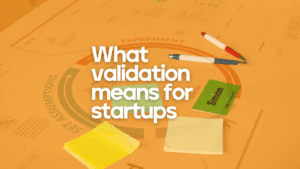When starting a business, you often hear people talking about “validating”stuff. Sometimes, it sounds like these buzzwords are just thrown around because others expect to hear them. And even worse, it seems like different people have different ideas of what validation means. The saddest part is when teams finish a startup program and still don’t understand what validation is. Or they’re not honest enough to admit the results of their validation efforts.
Here I decided to explain to myself and to all interested in startup success, what validation means in general, how to do “real validation” compared to “junk validation”, and explain each type of validation I could hear around, including:
- Customer validation
- Market validation
- Idea validation
- Concept validation
- Product validation
- Business model validation
- Business validation
Starting with the best kept secret – validation definition.
What is validation for a startup?
Validation is the process of gathering evidence that proves or disproves assumptions a startup has about its business. It is like checking out if your startup ideas have future. If they have someone who will care and create demand.
It ensures that there is a real need for the product, the market exists, and customers are willing to pay. The goal is to reduce the risk of wasting time and money on a product that nobody wants. Before you go all in, validation helps you make sure your core ideas are worth pursuing.
Validation can also be junk. It often is when people do it for the wrong reasons or go about it the wrong way. Like asking random people if they would buy your product.
The real validation involves getting hard data from real customers through direct interaction, purchase commitments, or product usage. It seeks concrete proof that the business model and product will work in the real world.
Junk validation has superficial signals that may appear positive but don’t provide true insights into whether a startup can succeed. It just looks good on the surface – or not even that. This can happen when people don’t start with a clear hypothesis, choose the wrong testing methods, don’t focus on customer segmentation, or don’t put enough effort into doing the validation experiments. And it all starts with being too focused on the idea instead of the problem.
I’ve also been thinking about explaining how to avoid junk validation, but let’s take a step back and first understand the different types of validation.
Types of validation and its meaning
Alright, let’s break down the different types of validation in a way that makes sense for startup founders like you and me. Let’s use an example of a mobile app that helps hard-working folks prevent lower back pain.
This type confirms that the startup is targeting the right customer segment and that those customers truly need the solution. The objective here is to discover the real need or a problem you are about nto solve. This type of validaton is most efficient in personal contact with the target customer, during aninterview or simple observation.
Taking an example of a mobile app designed for lower back pain prevention, customer validation might involve interviewing people who suffer from lower back pain, learning about their struggles, and confirming that they would use an app to help manage or prevent pain. Lucky for you, you discover through interviews that office workers experience back pain frequently and express interest in a daily exercise app.
Market validation objective is to conclude if there’s a large enough market demand for the product to justify building it. Market size and growth as two key elements are suplemented with information on trends and competition.
For a back pain prevention app, this would involve researching how many people experience lower back pain globally or within a specific region and if they’re actively seeking solutions.
After we discovered the need and market that is big enough, idea validation tests if the idea for solving a problem meets the expectations of the target audience. Depending on the case, it can involve landing pages, social media campaigns, explainer videos, presale etc.
For the app, this could involve sharing the core idea—daily stretches and posture advice with notifications—with potential users to gauge their interest.
Concept validationgoes one step further and tests solution’s design or functionality to see if it meets the needs of the target audience. It typically involves mockups, early prototypes, or wireframes. Testing users reaction to the initial wireframes of the app that show simple, easy-to-follow stretching exercises with video tutorials, to validate the concept is on the right track.
Product validation ensures the product functions as intended and meets user expectations. This type of validation can be very similar to “concept validation” and in some cases it can be validated in one step. For the back pain app, this might include launching a beta version to a small group of users to collect feedback on the exercises, user interface, and reminders. During beta testing, users can report improved back pain and high engagement with the daily reminders, validating the product’s value.
Business model validation tests if the proposed business model is viable, including stabile revenue. This is a multi-step process as a regular business model has 9 different components and each can be validated in multiple iterations in its own.
For example, the app might have a freemium model, with free content and paid premium features. Testing this could involve offering both options to users and seeing if they’re willing to pay for advanced tracking features or personalized plans.
This one may be obsolete, as we have covered the most with the abovementioned “Business model validation”, but in case the business model is a clone, so it has previously been validated in another market, then business validation makes sense. Business validation ensures that the entire app concept, from product to revenue generation, can succeed in the market. This involves testing scalability, operations, and sales channels.
In this introduction article, I’ve broken down the different types of validation in the order they usually happen, from when a startup first starts out to when it’s all grown up. The validation process for a startup can be a long and winding road, lasting several years before the business becomes sustainable. There are tons of ways to mess it up though, and if you’re not careful, you might end up feeling like you’re doing the right thing when you’re actually way off track. To help you avoid those common pitfalls and save you some precious time and resources, we’ll be sharing some insights in my next post. Stay tuned!
In the meantime, think about your own business ideas, their riskiest assumtions and what is the most effective way to de risk and validate.
To keep yourself updated you can subscribe to our newsletter.
If you’re thinking about starting up a program to help startups test their ideas and build stuff people actually want, we’d love to chat. Book a free consultation with us – our experts can give you tips on what works and what doesn’t.





